 Soviet Military Power
Soviet Military Power Soviet Military Power
Soviet Military Power
Over the last 25 years, the Soviets have increased their active and passive defenses in a clear and determined attempt to blunt the effect of any attack on the Soviet Union. The USSR has major passive defense programs, including civil defense and structural hardening, designed to protect important assets from attack. It also has extensive active defense systems which utilize weapons systems to protect national territory, military forces, or key assets. Soviet developments in the area of active defenses fall into three major categories: air defense; ballistic missile defense based on current technologies; and research and development on advanced defenses against ballistic missiles.
Important recent activities in the Soviet Strategic Defense Program (SSDP) include:
-upgrading and expanding the world's only operational ABM system around Moscow;
-construction of the Krasnoyarsk ballistic missile detection and tracking radar,which violates the 1972 ABM Treaty;
-extensive research into advanced technologies for defense against ballistic missiles, including laser weapons, particle beam weapons, and kinetic energy weapons;
- maintaining the world's only operational antisatellite (ASAT) system;
-modernizing their strategic air defense forces; and
-improving passive defenses by maintaining deep bunkers and blast shelters for key personnel and enhancing the survivability of some offensive systems through mobility and hardening.
Evidence of the importance the Soviets attach to defensive damage limitation can be traced to the beginning of the nuclear age. The National Air Defense Forces became an independent service in the late 1950s and since 1959 have generally ranked third in precedence within the Soviet Armed Forces, following the Strategic Rocket Forces and the Ground Forces.
By the mid-1960s, two new mission areas - ASAT operations and ABM defense - were added to the National Air Defense mission. As a result, Soviet strategic defense against ballistic missiles includes the world's only operational ABM system and a large and expanding research and development program. In addition, the Soviets have the world's only operational antisatellite system, which has the capability to destroy critical US and other satellites in low-earth orbit.
The Soviet emphasis on the necessity of research on ballistic missile defense was demonstrated in 1972 by then-Minister of Defense Grechko shortly after the signing of the ABM Treaty. Speaking to the Soviet Presidium, he said that the Treaty "places no limitations whatsoever on the conducting of research and experimental work directed towards solving the problem of defending the country from nuclear missile strikes."
The Soviet emphasis on strategic defense is firmly grounded in Soviet military doctrine and strategy. In the event of nuclear war, Soviet offensive forces are to:
-destroy or disrupt enemy nuclear associated command, control, and communications; and
-destroy or neutralize as many of the enemy's nuclear weapons as possible on the ground or at sea before they are launched.
Soviet defensive forces, lending greater credibility to offensive forces, are to:
-intercept and destroy surviving weapons - aircraft and missiles - before they reach their targets; and
-protect the Party, the state, military forces, industrial infrastructure, and the essential working population with active and passive measures against those weapons that survive attacks by Soviet offensive forces.
In pursuit of these goals, the USSR places considerable stress on the need for effective strategic defenses as well as offensive forces. In the Soviet view, the USSR could best achieve its aims in a nuclear war if it attacks first, destroying much of the US and allied capability for retaliation. Defensive measures, both active and passive, would in turn prevent those enemy forces that survived a Soviet first strike from destroying targets in the USSR.
In Military Strategy-originally published in 1962 - Marshal V.D. Sokolovskiy defined the aim of Soviet strategic defenses in this way:"They have the task of creating an invincible system for the defense of the entire country....While, in the last war, it was sufficient to destroy 15-20 percent of the attacking air operation, now it is necessary to assure, essentially, 100 percent destruction of all attacking airplanes and missiles." Soviet defensive force developments over the past 25 years demonstrate that the strategy articulated by Sokolovskiy still applies.
 The world's only
operational ABM system is maintained around Moscow. In 1978, the Soviets began to upgrade and expand that system to the limit allowed by the 1972 ABM Treaty. The original single-layer Moscow ABM system included 64 reloadable above-ground launchers at 4 complexes and DOG HOUSE and CATHOUSE battle management radars south of Moscow. Each complex consisted of TRY ADD tracking and guidance radars and GALOSH exoatmospheric interceptors (nuclear armed, ground-based missiles designed to intercept warheads in space shortly before they reenter the Earth's atmosphere).
The world's only
operational ABM system is maintained around Moscow. In 1978, the Soviets began to upgrade and expand that system to the limit allowed by the 1972 ABM Treaty. The original single-layer Moscow ABM system included 64 reloadable above-ground launchers at 4 complexes and DOG HOUSE and CATHOUSE battle management radars south of Moscow. Each complex consisted of TRY ADD tracking and guidance radars and GALOSH exoatmospheric interceptors (nuclear armed, ground-based missiles designed to intercept warheads in space shortly before they reenter the Earth's atmosphere).
When completed, the modernized Moscow ABM system will be a two-layer defense composed of silo-based, long-range, modified GALOSH interceptors; silo-based GAZELLE high-acceleration endoatmospheric interceptors designed to engage targets within the atmosphere; associated engagement, guidance and battle management radar systems; and a new large radar at Pushkino designed to control ABM engagements. The silo-based launchers may be reloadable. The new system will have the 100 ABM launchers permitted by the ABM Treaty and could be fully operational by 1987.
The Soviet system for detection and tracking of ballistic missile attack consists of a launch-detection satellite network, over-the-horizon radars, and a series of large phased-array radars.
The current launch-detection satellite network can provide about 30 minutes warning after any US ICBM launch and can determine the general origin of the missile. Two over-the-horizon radars directed at the US ICBM fields also could give the same 30 minutes warning.
The next operational layer of ballistic missile detection consists of 11 large HEN HOUSE ballistic missile early warning radars at 6 locations on the periphery of the USSR. These radars can distinguish the size of an attack, confirm the warning from the satellite and over-the-horizon radar systems, and provide target-tracking data in support of antiballistic missile forces. The capability of these radars has been improved since the signing of the ABM Treaty.
The Soviets are now constructing a network
of six new large phased-array radars that can track more ballistic missiles with greater accuracy than the existing HEN HOUSE network.Five of these radars duplicate or supplement the coverage of the HEN HOUSE network,but with greatly enhanced capability. Thesixth, under construction near Krasnoyarsk in Siberia, closes the final gap in the Soviet early warning radar coverage against ballistic missile attack. Together, the six new large phased array radars form an arc of coverage from the Kola Peninsula in the northwest Soviet Union, around Siberia, to the Caucasus in the southwest.

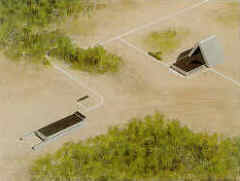

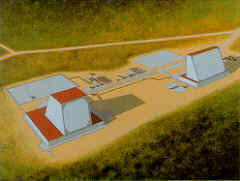
The United States is now constructing new ballistic missile early warning radars, known as PAVE PAWS, that are located on the periphery of our territory and oriented outward. These radars are much less capable than Soviet large phased-array radars. Both the US and the USSR, in signing the ABM Treaty, recognized the need for ballistic missile early warning radars. At the same time, they recognized that ballistic missile early warning radars can detect and track warheads at great distances and therefore have a significant antiballistic missile potential. Such an ABM capability would play an important role in a nationwide ABM defense, which the treaty was designed to prevent. As a result, the US and the Soviet Union agreed that future ballistic missile early warning radars must be located on a nation's periphery and be oriented outward. In that way, the desirable and legitimate goal of early warning could be advanced while minimizing the danger that an effective nationwide battle management network could result.
The Krasnoyarsk radar is designed for ballistic missile detection and tracking, including ballistic missile early warning. It violates the 1972 ABM Treaty as it is not located within a 150-kilometer radius of the national capital (Moscow) as required of ABM radars, nor is it located on the periphery of the Soviet Union and pointed outward as required for early warning radars. It is 3,700 kilometers from Moscow and is situated some 750 kilometers from the nearest border - Mongolia. Moreover, it is oriented not toward that border, but across approximately 4,000 kilometers of Soviet territory to the northeast.
The Soviet Union has claimed that the Krasnoyarsk radar is designed for space tracking, rather than ballistic missile early warning, and therefore does not violate the ABM Treaty. Its design, however, is not suited for a space tracking role, and the radar would, in any event, contribute little to the existing Soviet space-tracking network. Indeed, the design of the Krasnoyarsk radar is essentially identical to that of other radars that are known - and acknowledged by the Soviets - to be for ballistic missile detection and tracking, including ballistic missile early warning.
The growing Soviet network of large phased array, ballistic missile detection and tracking radars, of which the Krasnoyarsk radar is apart, is of particular concern when linked with other Soviet ABM efforts. Such radars take years to construct and their existence might allow the Soviet Union to move rather quickly to construct a nationwide ABM defense if it chooses to do so.
The Soviets also are developing components of a new ABM system that would allow them to construct individual ABM sites in a matter of months rather than the years that are required for more traditional ABM systems. Soviet activities in this regard potentially violate the ABM Treaty's prohibition on the development of a mobile land-based ABM system or components. We estimate that by using these components the Soviets could by the early 1990s quickly deploy an ABM system to strengthen the defenses of Moscow and defend key targets in the western USSR and east of the Urals.
In addition, the Soviets have probably violated the prohibition on testing surface-to-air missile (SAM) components in an ABM mode by conducting tests involving the use of SAM air defense radars in ABM-related testing activities. Moreover, the SA-10 and SA-X-12 SAMsystems may have the potential to intercept some types of strategic ballistic missiles.
Taken together, all of the Soviet Union's ABM and ABM-related activities are more significant - and more ominous - than any one considered individually. Cumulatively, they suggest that the USSR may be preparing to deploy rapidly an ABM defense of its national territory, contrary to the provisions of the ABMTreaty.
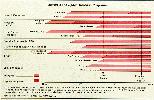 In the late 1960s, in line with its longstanding emphasis on strategic defense, the Soviet Union initiated a substantial research program into advanced technologies, some of which are
applicable for defense against ballistic missiles. That program covers many of the same technologies involved in the US Strategic Defense Initiative but represents a far greater investment of plant space, capital, and manpower.
In the late 1960s, in line with its longstanding emphasis on strategic defense, the Soviet Union initiated a substantial research program into advanced technologies, some of which are
applicable for defense against ballistic missiles. That program covers many of the same technologies involved in the US Strategic Defense Initiative but represents a far greater investment of plant space, capital, and manpower.
The USSR's laser program is much larger than US efforts and involves over 10,000 scientists and engineers and more than a half dozen major research and development facilities and test ranges. Much of this research takes place at the Sary Shagan Missile Test Center where the Soviets also conduct traditional ABM research. Facilities there are estimated to have several lasers for air defense, lasers capable of damaging some components of satellites in orbit, and a laser that could be used in feasibility testing for ballistic missile defense applications. A laser weapons program of the magnitude of the Soviet Union's effort would cost roughly $1 billion per year in the United States.
The Soviets are conducting research on three types of gas lasers considered promising for weapons applications - the gas-dynamic laser, the electric discharge laser, and the chemical laser. Soviet achievements in this area, in terms of output power, have been impressive. The Soviets also are aware of the military potential of visible and very shortwave-length lasers. They are investigating excimer, free-electron, and x-ray lasers and have been developing argon-ion lasers for over a decade.
The Soviets appear generally capable of supplying the prime power, energy storage, and auxiliary components needed for most laser and other directed-energy weapons. They have developed a rocket-driven magnetohydro-dynamic generator which produces over 15 megawatts of electrical power - a device that has no counterpart in the West. The Soviets may also have the capability to develop the optical systems necessary for laser weapons to track and attack their targets. They produced a 1.2-meter segmented mirror for an astrophysical telescope in 1978 and claimed that this was a prototype for a 25-meter mirror. A large mirror is considered necessary for a space-based laser weapon.
Unlike the US, the USSR has now progressed in some cases beyond technology research. It already has ground-based lasers that have a limited capability to attack US satellites and could have prototype space-based antisatellite laser weapons by the end of the decade. The Soviets could have prototypes for ground-based lasers for defense against ballistic missiles by the late 1980s and could begin testing components for a large-scale deployment system in the early 1990s.
The remaining difficulties in fielding an operational system will require more development time. An operational ground-based laser for defense against ballistic missiles probably could not be deployed until the late 1990s or after the year 2000. If technology developments prove successful, the Soviets may deploy operational space-based antisatellite lasers in the mid-to late 1990s and might be able to deploy space based laser systems for defense against ballistic missiles after the year 2000. The Soviets' efforts to develop high-energy air defense laser weapons are likely to lead to ground-based deployments in the early 1990s and naval deployments in the mid-199Os.
Since the late 1960s, the Soviets have been involved in research to explore the feasibility of space-based weapons that would use particle beams. We estimate that they may be able to test a prototype particle beam weapon intended to disrupt the electronics of satellites in the 1990s. A weapon designed to destroy satellites could follow later. A weapon capable of physically destroying missile boosters or warheads probably would require several additional years of research and development.
Soviet efforts in particle beams, and particularly ion sources and radio frequency quadrapole accelerators for particle beams, are very impressive. In fact, much of the US understanding of how particle beams could be made into practical defensive weapons is based on Soviet work conducted in the late 1960s and early 1970s.
The USSR has conducted research in the use of strong radio frequency signals that have the potential to interfere with or destroy critical electronic components of ballistic missile warheads or satellites. The Soviets could test a ground-based radio frequency weapon capable of damaging satellites in the 1990s.
The Soviets also have a variety of research programs underway in the area of kinetic energy weapons, using the high-speed collision of a small mass with the target as the kill mechanism. In the 1960s, the USSR developed an experimental "gun" that could shoot streams of particles of a heavy metal such as tungsten or molybdenum at speeds of nearly 25 kilometers per second in air and over 60 kilometers per second in a vacuum.
Long-range, space-based kinetic energy systems for defense against ballistic missiles probably could not be developed until the mid 1990s or even later. The USSR could, however, deploy in the near-term a short-range, space based system useful for satellite or space station defense or for close-in attack by a maneuvering satellite. Soviet capabilities in guidance and control systems probably are adequate for effective kinetic energy weapons for use against some objects in space.
Advanced technology weapons programs - including potential advanced defenses against ballistic missiles and ASATs - are dependent on remote sensor and computer technologies, areas in which the West currently leads the Soviet Union. The Soviets, therefore, are devoting considerable resources to acquiring Western know-how and improving their abilities and expertise in these technologies. An important part of that effort involves the increasing exploitation of open and clandestine access to Western technology. For example, the Soviets have long been engaged in a well funded effort to purchase illegally US high technology computers, test and calibration equipment, and sensors through third parties.
 The USSR has had for more than a dozen years the world's only operational antisatellite system, which is launched into the same orbit as its target satellite and, when it gets close enough, destroys the satellite by exploding a conventional warhead. Given the complexity of launch, target tracking, and radar-guided
intercept, the Soviet ASAT system is far from primitive. Soviet ASAT tests have been largely successful, indicating an operational system fully capable of performing its mission. In addition, the nuclear-armed GALOSH ABM
interceptor deployed around Moscow has an inherent ASAT capability, and Soviet ground-based lasers may be able to damage some components of satellites. Furthermore, as noted previously, the Soviets are engaged in research and, in some cases, development of weapons which ultimately may serve as ballistic missile defense systems but probably will first provide ASAT capabilities.
The USSR has had for more than a dozen years the world's only operational antisatellite system, which is launched into the same orbit as its target satellite and, when it gets close enough, destroys the satellite by exploding a conventional warhead. Given the complexity of launch, target tracking, and radar-guided
intercept, the Soviet ASAT system is far from primitive. Soviet ASAT tests have been largely successful, indicating an operational system fully capable of performing its mission. In addition, the nuclear-armed GALOSH ABM
interceptor deployed around Moscow has an inherent ASAT capability, and Soviet ground-based lasers may be able to damage some components of satellites. Furthermore, as noted previously, the Soviets are engaged in research and, in some cases, development of weapons which ultimately may serve as ballistic missile defense systems but probably will first provide ASAT capabilities.
 The Soviets operate several space systems that support both military and civil users. These include manned spacecraft, reconnaissance and surveillance vehicles, new space boosters, and a variety of other support systems. The Soviets have made progress in their space plane and space shuttle programs, with the first flight of a Soviet shuttle expected in late 1986 or 1987.
The Soviets operate several space systems that support both military and civil users. These include manned spacecraft, reconnaissance and surveillance vehicles, new space boosters, and a variety of other support systems. The Soviets have made progress in their space plane and space shuttle programs, with the first flight of a Soviet shuttle expected in late 1986 or 1987.
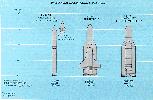 The primary focus of Soviet space operations is military, as evidenced by the fact that at least 70 percent of Soviet space launches are purely military in nature and support both offensive and defensive operations. The USSR attempts to mask the true nature of most of its space programs by declaring that launches are"scientific," usually without providing details on what kind of "scientific" mission is being conducted. The results of these "scientific"missions are rarely published or even disclosed.
The primary focus of Soviet space operations is military, as evidenced by the fact that at least 70 percent of Soviet space launches are purely military in nature and support both offensive and defensive operations. The USSR attempts to mask the true nature of most of its space programs by declaring that launches are"scientific," usually without providing details on what kind of "scientific" mission is being conducted. The results of these "scientific"missions are rarely published or even disclosed.
The Soviets are increasing their efforts to develop and deploy space systems to support military operations. They now operate several space-based reconnaissance and surveillance systems, two of which have no US counterpart. The latter are the nuclear powered Radar Ocean Reconnaissance Satellite (RORSAT) and the Electronic Intelligence Ocean Reconnaissance Satellite (EORSAT), both of which are used to locate and target naval forces. Two RORSATs were launched in August 1985 in time to support a Soviet naval exercise in September. This was not the first time RORSAT launchings have taken place prior to military exercises.
The Soviet satellite reconnaissance program has matured and has incorporated significant enhancements. The Soviets have improved their satellite imagery reconnaissance capability and are gradually improving their space based electronic intelligence assets as well. They have demonstrated great versatility and flexibility in launching and maintaining several surveillance systems in orbit and are capable of redirecting them for worldwide missions as situations dictate.
The Soviets continue to operate an extensive network of satellites for missile launch detection and attack warning missions. For a number of years, the USSR has had the capability to monitor US ICBM fields.
The Soviets have also pressed ahead with the development and deployment of a global navigation satellite system known as GLONASS. When fully developed, this system will provide three-dimensional (latitude, longitude, and altitude) positioning data.
Soviet Military Power 1985 reported two new space launch vehicles under development, a heavy-lift system and a medium-lift system. Launch pad compatibility testing has continued on the heavy-lift vehicle, a Saturn V-Classbooster, and the Soviets have flight-tested the Titan III-Class medium-lift vehicle.
The heavy-lift booster system apparently will be used to launch the Soviet shuttle orbiter, a craft similar to the US space shuttle orbiter. This launch system will also be able to carry very heavy payloads of about 100,000 kilograms, enabling the Soviets to assemble very large modular space stations in orbit. This type of system could also be instrumental in the launch of other heavy payloads, such as directed-energy ASAT and ballistic missile defense weapons.
The medium-lift booster may be used to launch the Soviet space plane, which is a different program from the space shuttle. This small, manned craft could be used for real-time reconnaissance missions, satellite repair and maintenance, crew transport, space station defense, and enemy satellite inspection or destruction.
When these new launch systems become operational, the Soviets will have ten different types of expendable launch vehicles and two reusable manned space vehicles. These systems will give the Soviets a versatile and redundant capability to conduct and augment military operations in space. In addition, the Soviets would have a distinct advantage during times of crises or hostilities because of the launch surge capability provided by their large number of launch vehicles.
 In early 1985, the Soviets experienced trouble with their SALYUT-7 space station that resulted in failure of its electrical system. They announced in March it had fulfilled its mission and was being "mothballed." In June, however, two cosmonauts were launched from Tyuratam aboard SOYUZ T-13. Using manual rendezvous procedures, the cosmonauts succeeded in docking with the inactive station. Efforts to revive the space station commenced, and within two weeks the crew was operating the station normally and was probably conducting military-related experiments. This repair mission provided valuable experience in space station maintenance that will contribute greatly to Soviet efforts to achieve a significant, permanent manned presence in near-Earth orbit.
In early 1985, the Soviets experienced trouble with their SALYUT-7 space station that resulted in failure of its electrical system. They announced in March it had fulfilled its mission and was being "mothballed." In June, however, two cosmonauts were launched from Tyuratam aboard SOYUZ T-13. Using manual rendezvous procedures, the cosmonauts succeeded in docking with the inactive station. Efforts to revive the space station commenced, and within two weeks the crew was operating the station normally and was probably conducting military-related experiments. This repair mission provided valuable experience in space station maintenance that will contribute greatly to Soviet efforts to achieve a significant, permanent manned presence in near-Earth orbit.
Last September, the Soviets conducted the first space station crew rotation in the history of manned space flight when SOYUZ T-14 delivered three additional cosmonauts to SALYUT-7. One T-13 cosmonaut and one T-14 cosmonaut subsequently deorbited on SOYUZ T-13. Crew rotation will become common place when the Soviets deploy their first large modular space station, which is likely to be launched in the late 1980s. The Soviets took a major step toward this capability with the launch of an advanced SALYUT station with six docking ports in early 1986.
Further progress toward a deployment of a new station was demonstrated by COSMOS-1686, which docked with SALYUT-7 in early October 1985. Such modules have a high capacity cargo transport capability and could be outfitted as reconnaissance platforms, nuclear power "substations," or laboratories for various types of research and experimentation.
These modules will serve as interchangeable components of future large modular space stations, and each, is capable of autonomous operation. Once deployed, this space station will provide the Soviets with a manned space based military capability for missions such as reconnaissance, command and control, ASAT, and ballistic missile defense support operations as well as satellite maintenance and repair. Such space stations will probably be serviced and supported by the Soviet shuttle and space plane.
The Soviets have realized that men in space can significantly contribute to military operations. Soviet cosmonauts aboard a space station in low-earth orbit can observe large areas of the Earth's surface and transmit real-time information to military forces below. From the altitude at which SALYUT operates, much of the Earth's surface can be seen with great clarity. If supported with optics, a cosmonaut could make out details such as airfields, port facilities, major transportation routes, and ships at sea.
In the more traditional areas of strategic defense, Soviet military doctrine calls for passive and active defenses to act in conjunction to ensure wartime survival. Physical hardening of military assets to make them more resistant to attack is an important passive defense technique. The USSR has hardened its ICBM silos, launch facilities, and key command and control centers to an unprecedented degree. Much of the current US retaliatory force would be ineffective against these hardened targets.
Soviet leaders and managers at all levels of the government and Communist Party are provided hardened alternate command posts located well away from urban centers - in addition to many deep bunkers and blast shelters in Soviet cities. This comprehensive and redundant system, patterned after a similar system designed for the Soviet Armed Forces, provides more than 1,500 hardened alternate facilities for more than 175,000 key Party and government personnel throughout the USSR. In contrast, the US passive defense effort is far smaller and more limited; it is in no way comparable to the comprehensive Soviet program.
Elaborate plans also have been made for the full mobilization of the national economy in support of the war effort. Reserves of vital materials are maintained, many in hardened underground structures. Redundant industrial facilities are in active production. Industrial and other economic facilities have been equipped with blast shelters for the work force, and detailed procedures have been developed for the relocation of selected production capabilities. By planning for the survival of the essential work force, the Soviets hope to reconstitute vital production programs using those industrial components that could be redirected or salvaged after an attack.
In addition, the USSR has greatly emphasized mobility as a means of enhancing the survivability of military assets. The SS-20 and SS-25 missiles, for example, are mobile. Rail mobile deployment of the SS-X-24 is expected soon. The Soviets are also developing an extensive network of mobile command, control, and communications facilities.
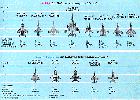 The Soviet Union has since the 1950s invested enormous resources in a wide array of strategic air defense weapons systems. Taken together, the Soviet strategic air defense network is a potent and increasingly capable force which would attempt to limit the retaliatory capability of our strategic bombers and cruise missiles. With the emergence of the Soviet cruise missile and the enhanced bomber threat to the United States, the US has undertaken measures to improve its air defense capabilities.
The Soviet Union has since the 1950s invested enormous resources in a wide array of strategic air defense weapons systems. Taken together, the Soviet strategic air defense network is a potent and increasingly capable force which would attempt to limit the retaliatory capability of our strategic bombers and cruise missiles. With the emergence of the Soviet cruise missile and the enhanced bomber threat to the United States, the US has undertaken measures to improve its air defense capabilities.
The Soviets have deployed numerous strategic air defense systems with capabilities against aircraft flying at medium and high altitudes. They are now in the midst of a major program to improve their capabilities against aircraft and cruise missiles flying at low altitudes. That effort includes partial integration of strategic and tactical air defense assets, the upgrading of early warning and surveillance capabilities, the deployment of more efficient data transmission systems, and the development and initial deployment of new aircraft, associated air-to-air missiles, surface-to-air missiles (SAMs), and airborne warning and control system (AWACS) aircraft.
 Currently, the Soviets have more than 9,000 strategic SAM launchers, over 4,600 tactical SAM launchers, and some 10,000 air defense radars. More than 1,200 Air Defense Forces interceptor aircraft are dedicated to strategic defense. An additional 2,800 interceptors assigned to Soviet Air Forces (SAF) will be drawn upon for strategic defense missions. Collectively, these assets present a formidable defense barrier against any attack.
Currently, the Soviets have more than 9,000 strategic SAM launchers, over 4,600 tactical SAM launchers, and some 10,000 air defense radars. More than 1,200 Air Defense Forces interceptor aircraft are dedicated to strategic defense. An additional 2,800 interceptors assigned to Soviet Air Forces (SAF) will be drawn upon for strategic defense missions. Collectively, these assets present a formidable defense barrier against any attack.
 The most capable Soviet air defense interceptor aircraft, the MiG-31/FOXHOUND, has a look-down/shoot-down and multiple-target engagement capability. More than 100 FOXHOUNDs are now operationally deployed at several locations from the Arkhangelsk area in the northwestern USSR to the Far East Military District. Two new fighter interceptors, the SU-27/FLANKER and the MiG-29/FULCRUM, also have look-down/shoot-down capabilities and are designed to be highly maneuverable in air-to-air combat. The look-down/shoot-down capability was acquired from the US through espionage. The Soviets have deployed over 100 MiG-29/FULCRUM aircraft to operational units and have recently begun to deploy the Su27/FLANKER. These three aircraft are equipped with two new air-to-air missiles - the long-range AA-9 (for the FOXHOUND) and
the medium-range AA-10 (for the FULCRUMand FLANKER - that can be used against low flying targets.
The most capable Soviet air defense interceptor aircraft, the MiG-31/FOXHOUND, has a look-down/shoot-down and multiple-target engagement capability. More than 100 FOXHOUNDs are now operationally deployed at several locations from the Arkhangelsk area in the northwestern USSR to the Far East Military District. Two new fighter interceptors, the SU-27/FLANKER and the MiG-29/FULCRUM, also have look-down/shoot-down capabilities and are designed to be highly maneuverable in air-to-air combat. The look-down/shoot-down capability was acquired from the US through espionage. The Soviets have deployed over 100 MiG-29/FULCRUM aircraft to operational units and have recently begun to deploy the Su27/FLANKER. These three aircraft are equipped with two new air-to-air missiles - the long-range AA-9 (for the FOXHOUND) and
the medium-range AA-10 (for the FULCRUMand FLANKER - that can be used against low flying targets.
The USSR is also deploying the MAINSTAYAWACS aircraft, which will improve substantially Soviet capabilities for early warning and air combat command and control, especially against low-flying aircraft. The MIDAS, a tanker variant of the Il-76/CANDID which should be operational soon, will significantly increase the endurance of the new air defense aircraft, particularly the MAINSTAY and some of the new fighters - if an air refueling capability for them is incorporated.
 The Soviets maintain the world's most extensive early warning system for air defense. It is composed of a widespread network of ground-based radars linked operationally with those of their Warsaw Pact allies. As previously noted, more than 10,000 air surveillance radars of various types provide virtually complete coverage at medium-to-high altitudes over the USSR and, in some areas, well beyond the Soviet Union's borders. Three over-the-horizon radars for ballistic missile detection could provide additional warning of the approach of high-flying aircraft.
The Soviets maintain the world's most extensive early warning system for air defense. It is composed of a widespread network of ground-based radars linked operationally with those of their Warsaw Pact allies. As previously noted, more than 10,000 air surveillance radars of various types provide virtually complete coverage at medium-to-high altitudes over the USSR and, in some areas, well beyond the Soviet Union's borders. Three over-the-horizon radars for ballistic missile detection could provide additional warning of the approach of high-flying aircraft.
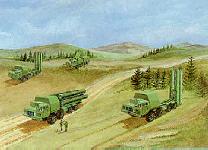 The USSR also has an active research and development program to improve its air surveillance network. In 1983, it began to deploy two new types of air surveillance radars which will enhance Soviet capabilities for air defense, electronic warfare, and early warning of cruise missile and bomber attacks. The Soviets are also continuing to deploy improved air surveillance data systems that can rapidly pass data from outlying radars through the air surveillance network to ground-controlled interceptor sites and SAM command posts.
The USSR also has an active research and development program to improve its air surveillance network. In 1983, it began to deploy two new types of air surveillance radars which will enhance Soviet capabilities for air defense, electronic warfare, and early warning of cruise missile and bomber attacks. The Soviets are also continuing to deploy improved air surveillance data systems that can rapidly pass data from outlying radars through the air surveillance network to ground-controlled interceptor sites and SAM command posts.
 Soviet strategic surface-to-air missiles provide low-to-high-altitude barrier, area, and terminal defenses under all weather condition. Five systems are now operational: the SA-1, SA-2, and SA-3, and the more capable SA-5 and SA-10. The recent Soviet air defense reorganization permits more efficient integration of strategic and tactical SAM systems. Although most tactical SAMs have a shorter range the their strategic counterparts, many have better capabilities against targets flying at low altitudes.
Soviet strategic surface-to-air missiles provide low-to-high-altitude barrier, area, and terminal defenses under all weather condition. Five systems are now operational: the SA-1, SA-2, and SA-3, and the more capable SA-5 and SA-10. The recent Soviet air defense reorganization permits more efficient integration of strategic and tactical SAM systems. Although most tactical SAMs have a shorter range the their strategic counterparts, many have better capabilities against targets flying at low altitudes.
Over the years the Soviets have continued to deploy the long-range SA-5 and have repeatedly modified this system. Further deployment and upgrading are probable to enhance the SA-5's capability to work in conjunction with low-altitude systems like the SA-10.
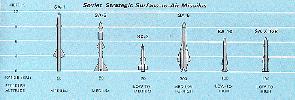 The SA-10 has some capability against low altitude targets with small radar cross-sections,such as cruise missiles. The first SA-10 site was, operation in 1980. Over 60 sites are now operational, and work is progressing on at least another 30. More than half of these sites are located near Moscow; this emphasis on Moscow and the patterns noted for the other SA-10 sites suggest a first priority on terminal defense of command and control, military, and key industrial complexes.
The SA-10 has some capability against low altitude targets with small radar cross-sections,such as cruise missiles. The first SA-10 site was, operation in 1980. Over 60 sites are now operational, and work is progressing on at least another 30. More than half of these sites are located near Moscow; this emphasis on Moscow and the patterns noted for the other SA-10 sites suggest a first priority on terminal defense of command and control, military, and key industrial complexes.
In keeping with their drive toward mobility as a means of weapons survival, the Soviets are in the process of deploying a mobile version of the SA-10. This mobile version could be used to support Soviet theater forces and to permit periodic changes in the location of SA-10 sites within the USSR to counter US retaliatory forces more effectively.
 The Soviets are also flight-testing another important mobile SAM system, the SA-X-12, which is capable of intercepting aircraft at all altitudes as well as cruise missiles and short range ballistic missiles. As previously noted, the SA-10 and SA-X-12 may have the potential to intercept some types of strategic ballistic missiles as well. This is a serious development because these systems are expected to be deployed widely throughout the Soviet Union in the 1980s. They could, if properly supported, add significant point-target defense coverage
to a nationwide Soviet ABM deployment.
The Soviets are also flight-testing another important mobile SAM system, the SA-X-12, which is capable of intercepting aircraft at all altitudes as well as cruise missiles and short range ballistic missiles. As previously noted, the SA-10 and SA-X-12 may have the potential to intercept some types of strategic ballistic missiles as well. This is a serious development because these systems are expected to be deployed widely throughout the Soviet Union in the 1980s. They could, if properly supported, add significant point-target defense coverage
to a nationwide Soviet ABM deployment.